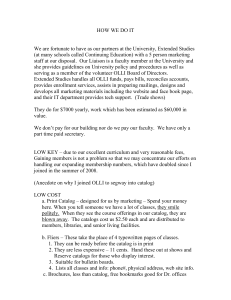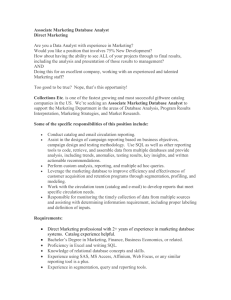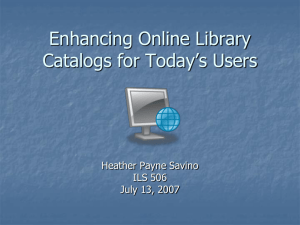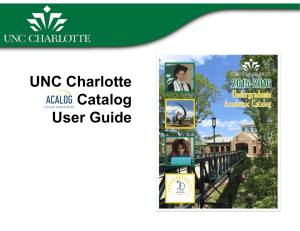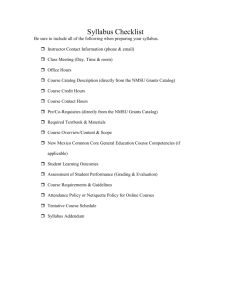ppt - Infopeople
advertisement
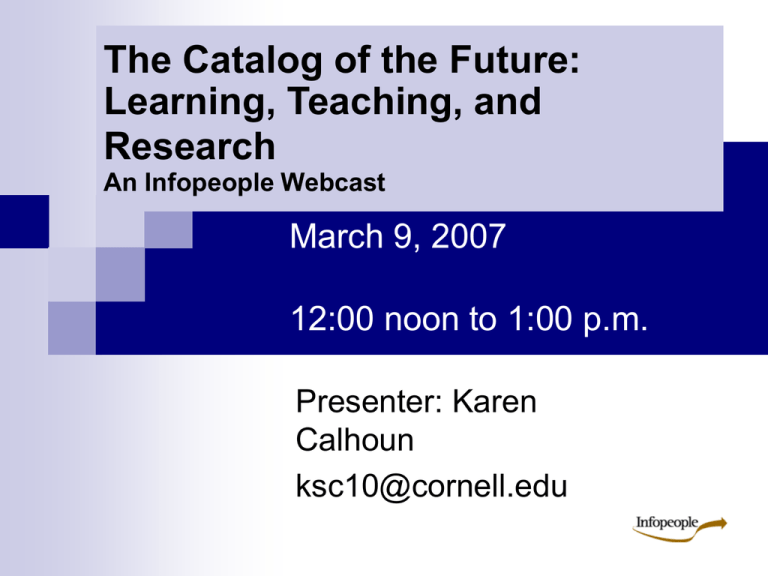
The Catalog of the Future: Learning, Teaching, and Research An Infopeople Webcast March 9, 2007 12:00 noon to 1:00 p.m. Presenter: Karen Calhoun ksc10@cornell.edu My Report to the Library of Congress Calhoun, Karen. The Changing Nature of the Catalog and Its Integration with Other Discovery Tools Washington, DC: Library of Congress, March 17 2006 http://www.loc.gov/catdir/calhoun-report- final.pdf My Thesis: We Need to Rethink the Catalog in Light of a Changed World WHO? Users are not getting what they need from online libraries and catalogs Content has changed Users have changed The library service model must change The catalog must change WHAT? HOW? WHERE? Agenda Section 1: Questions about the catalog Section 2: Library service model and the role of the catalog Section 3: New service model Section 4: Revitalizing the catalog Section 5: What’s possible today and tomorrow Unanswered Questions 1. 2. 3. Who uses online catalogs and library Web pages? Compared to what? Are users getting what they need from online catalogs? From Tim Burke’s Blog, Easily Distracted: Burn the Catalog! “I’m to the point where I think we’d be better off to just utterly erase our existing academic catalogs and forget about backwardscompatibility…” http://www.swarthmore.edu/SocSci/ tburke1/perma12004.html Tim Burke, Swarthmore College, Jan. 20, 2004 More Unkind Words About the Catalog As information systems, catalogs are hard to use Quote from Yu, Holly and Margo Young. 2004. “The impact of Web search engines on subject searching in OPAC.” ITAL 23 (4). “In spite of many studies…many of the original ideas about improving user success …have yet to be implemented. Ironically, many of these techniques are now found in Web search engines.” Who Uses the Online Catalog? 70 61.2 60 50 Percent 40 30 20 Never At least once a week 15.9 8.6 10 1.5 0 Undergraduate Graduate Surveying the Students: the 2005 Student Survey On the University of Virginia Library. p. 15 http://www.lib.virginia.edu/mis/reports/stusurv05/ultra_short_final.pdf The Net Generation = Millennials Net Generation 1982-1991 Lippincott, Joan. 2005. “Net Generation Students and Libraries” http://www.educause.edu/educatingthenetgen Lippincott: The Net Generation & Library Services: A Disconnect They like We offer Multimedia Text-based environments Figuring things out for themselves Working in groups Multitasking Active engagement & learning directly related to courses environments Systems that require prior understanding (or librarian help) Services for individual use Catalogs, databases, etc. Review of Unanswered Questions Who uses the online catalog? faculty and graduate students (comparatively more) students (comparatively less) librarians Who uses library Web pages? How much? strong preference for search engines Where Do You Begin a Search for Information on a Topic? 100 84 80 60 Search engine Library Web site Percent 40 20 1 0 Perceptions of Libraries and Information Resources: a Report to the OCLC Membership. http://www.oclc.org/reports/2005perceptions.htm Competition for Catalogs? FigureThis! Cited in “Study Haul: Sites help parents grapple with homework issues,” San Diego Union Tribune, October 14, 2006. Full Text: Digital Repositories and Interactive Learning http://valley.vcdh.virginia.edu/ More Competition? Social Networks ‘Linked in’ appears to be the next widespread social network… The site, which claims 9 million worldwide users, is a way to foster business connections.” Cited in “Business networking site adds $12.8 million in funds,” Ventura County Star, Feb. 5, 2007 Review of Unanswered Question 2: Compared to What? Strong preference for full text and media, other Web content Some are familiar with bibliographic data/tools, many are not (and find what they want anyway?) Personal and professional networking are important aspects of information seeking We Need to Rethink the Catalog in Light of a Changed World Users are not getting what they need from online libraries and catalogs Content has changed Users have changed WHO? The library service model must WHAT? HOW? change WHERE? The catalog must change VIVO: Connecting Life Sciences Researchers Combining social networking, traditional library services, and more The Well “They come and go and draw from the well” I Ching, hexagram 48, Ching – The Well • The Library as a center of collections • The Library as a center of experts and tools to guide users to appropriate resources The Way We Worked Books Journals Newspapers Gov docs Maps Scores AV Dissertations Library catalogs Special collections Manuscripts Papers Univ records Archives Journal articles Conference proceedings Etc. Abstracting & Indexing services Geocentric/ Aristotelian view: The local catalog is the sun Heliocentric/ Copernican view: The local catalog is a planet The River A New Kind of Library Be more involved with research and learning materials and systems Be more engaged with user communities Make library collections and librarians more visible Move to next generation systems and services An online social network The Larger Context: Knowledge Management Knowledge communities “interpret information about the environment in order to construct meaning … create new knowledge by converting and combining the expertise and know-how of their members … [and] analyze information in order to select and commit to appropriate courses of action.” —Chun Wei Choo, Professor of Information Studies, University of Toronto The Knowing Organization: How Organizations Use Information to Construct Meaning, Create Knowledge, and Make Decisions (New York: Oxford University Press, 1998) Knowledge Creation and Social Networks “Improving efficiency and effectiveness in knowledge-intensive work demands more than sophisticated technologies—it requires attending to the often idiosyncratic ways that people seek out knowledge, learn from and solve problems with other people.” —Rob Cross Rob Cross et al., “Knowing what we know” Organizational Dynamics 30, no. 2 (November 2001). A multidimensional framework for academic support: a final report submitted to the Mellon Foundation from the University of Minnesota Libraries, June 2006, p. 47. http://www.lib.umn.edu/about/mellon/docs.phtml Implications Citizens engage in information network processes with or without libraries Libraries, librarians, and the organizations that serve them need to design and align services with social networks and users’ information seeking behaviors Catalogs (that is, collections) need to be more visible in the user’s information space Toward a New Library/User Information Space Library as place From the master’s paper of Michael C. Habib,recent graduate of UNC LIS, “Academic Library 2.0 Concept Model,” p. 35. SEE HANDOUT Place as library “Place as library?” by Nancy Davenport, EDUCAUSE Review Jan./Feb. 2006 Outward Integration “Integration should be outward rather than inward, with libraries seeking to use their components in new ways” --Interviewee for Calhoun’s LC report on future of the catalog Second Life Library McMaster University Library (Canada) NMC Campus (New Media Consortium) Talis Cybrary City Second Life Library/Info Island San Jose State U. LIS School (virtual classes) Integration with Learning Management Systems Links to “Ask a Librarian” Links to Web-based citation management tools (like RefWorks) Links to specific licensed e-resources & course reserves Links to library-created materials (like webliographies) Integration with Search Engines: Google Scholar Why are online catalogs still hard to use? – Get it! Cornell … CL Borgman - Journal of The American Society for Information Science, 1996 Quiz: What Percentage of the World-Wide Printed Book Collection is Held by the Google 5 Libraries? A. 33% B. 10% C. 60% The Next Retrospective Conversion: Mass Digitization 30 26.1 25 20 Millions 15 10.5 Held by Google 5 Not Held 10 5 33% 0 Printed Books (Millions) Brian Lavoie et al. Anatomy of aggregate collections: the example of Google Print for libraries. http://www.dlib.org/dlib/september05/lavoie/09lavoie.html “Within the next five years … …there will no longer be …we’ll be past the a monolithic library notion that the Web site. Instead online catalog is library data will be the way you find pushed out to many things in libraries.”-starting places on the Interviewee for LC report Web and directly to users.”--Provocative Statement #6, Taiga Forum http://www.taigaforum.org/docs/ProvocativeStatements.pdf LEADERSHIP STRATEGY EXPAND STRATEGY EXTEND STRATEGY Invest in shared catalogs Link pools of scholarly data Seek partners Improve the user’s experience Greatly enhance delivery (fast!) Standards development/compliance Recycle and reuse catalog data Innovate and reduce costs SEE HANDOUT “Outward integration” Mass collections & catalogs Digitize Open access Participate in the substitute industry “Thirty-two Options & Three Strategies”— A Radical Abridgement Vision for Change: The Catalog – Leadership Strategy The catalog will evolve toward full integration with other discovery tools Shared catalogs and open information systems will radically democratize access to library collections and boost scholarly productivity to new levels The Continuing Importance of the Catalog Books and serials are not dead, and they are not yet digital ARL libraries spent the lion’s share of $665 million on books and serials in 2004 The legacy of the world’s library collections is tied to the future of catalogs! What’s Possible Today? Innovate and Reduce Costs Much better linkages: ingest, convert, extract, transfer Simplify & exploit all sources of catalog data Automate and streamline workflows Explore automatic classification, subject analysis; reengineer and automate LCSH practice Mine catalog data for new uses Are Innovation and Cost Reduction Really Possible? Comparison of Staff Size and Output Over Seven Years (Cornell) Percent Change 96-97 to 02-03: 140 120 100 Number FTE down 20% 80 60 Acquisitions up 18% 40 20 0 FTE FY 96-97 FY 02-03 Titles Added (Acq) (000s) Cataloging up 64% Titles Cataloged (000s) To Learn More about Technical Services Innovations and Cost Reductions Title: Libraries and Librarians Responding to Change: Transitions and Emerging Priorities Author: Calhoun, Karen Issue Date: 18-Mar-2005 URI: http://hdl.handle.net/1813/1473 What’s Possible Today? – Updated Interface for the the Local Online Catalog Aquabrowser http://aquabrowser.city.newport-beach.ca.us/ What’s Possible Today? - More Interactive and Visual Wordpress OPAC (WPopac) - Plymouth State University 2006 Mellon Award. plymouth.edu/library/opac/ What’s Possible Today? - Shared Catalogs with Improved Interfaces Georgia PINES’ Evergreen: 252 public libraries http://gapines.org What’s Possible Today? – Find Globally, Get Locally Worldcat.org / Find in a Library What’s Possible Tomorrow? – Unifying System Model Unified Web Interface (“Google-like”) Authentication layer Metadata/content aggregation layer Other Local Library Digital Catalogs Catalog Collections Licensed Other Databases (e.g.,DSpace) Many diverse, separate interfaces New Models for the Catalog: Linking Pools of Data Ex Libris – Primo http://www.exlibrisgroup.com/primo.htm Innovative Interfaces – Encore http://www.iii.com/encore/main_index2.html University of Rochester - eXtensible Catalog http://extensiblecatalog.info/ The Catalog and Teaching, Learning, and Research, the Next Generation Deconstruction AND Reinvention Phoenix detail from Aberdeen Bestiary (public domain) Thank You! Karen Calhoun, Cornell University Library ksc10@cornell.edu

